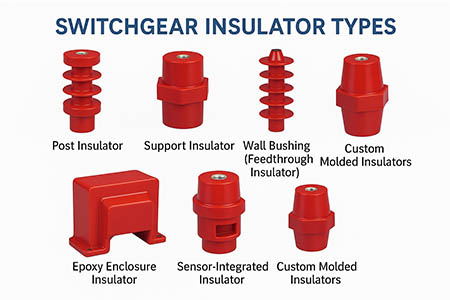Switchgear insulators are essential components in medium and high voltage power systems. Their primary role is to support and insulate live parts, ensuring operational safety and stability within switchgear assemblies. Among the various materials used, epoxy resin stands out for its excellent electrical insulation performance, mechanical strength, and adaptability to complex molding requirements.

In practical applications, six types of epoxy switchgear insulators are most frequently used due to their reliability and compatibility with different configurations:
Commonly used in vertical or horizontal mounting, it supports live parts and separates phases in compact switchgear designs.
Designed to mechanically support conductors or other components while maintaining insulation. Widely seen in gas-insulated and air-insulated switchgears.
Installed between compartments or enclosures, these insulators allow safe electrical passage through partitions, often in RMUs and modular cabinets.
Acts both as a structural shell and insulating barrier, used in sealed vacuum interrupters or solid insulated switchgear systems.
Combines insulation with voltage or current measurement capabilities, allowing compact smart-grid-ready designs.
Tailored for specific configurations or spatial constraints, especially in OEM switchgear production.
These epoxy switchgear insulators are widely adopted in 11kV to 40.5kV switchgear systems, especially in applications such as ring main units (RMUs), gas-insulated switchgear (GIS), air-insulated switchgear (AIS), and solid insulated switchgear (SIS). Their thermal endurance, partial discharge resistance, and precise molding accuracy make them ideal for both utility and industrial power distribution networks.
When selecting insulators, engineers often consider parameters such as rated voltage, creepage distance, mechanical load strength, and dimensional compatibility. With increasing trends in compact switchgear design and smart grid monitoring, integrated or hybrid insulators are gaining attention.